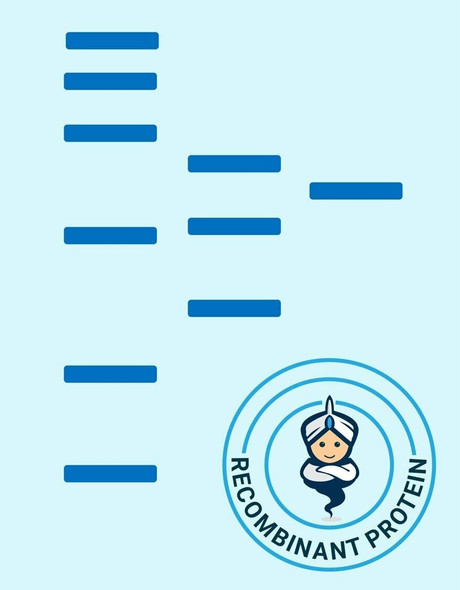Human PDPN Recombinant Protein (RPPB4216)
- SKU:
- RPPB4216
- Product type:
- Recombinant Protein
- Size:
- 25ug
- Species:
- Human
- Target:
- PDPN
- Synonyms:
- Podoplanin
- Glycoprotein 36
- PA226 antigen
- T1A
- Source:
- Escherichia Coli
- Uniprot:
- Q86YL7
Description
| Product Name: | Human PDPN Recombinant Protein |
| Product Code: | RPPB4216 |
| Size: | 25µg |
| Species: | Human |
| Target: | PDPN |
| Synonyms: | Podoplanin, Glycoprotein 36, PA2.26 antigen, T1A, GP36, GP40, Gp38, OTS8, T1A2, HT1A-1, PA2.26, T1-alpha, PDPN. |
| Source: | Escherichia Coli |
| Physical Appearance: | Sterile Filtered colorless solution. |
| Formulation: | The protein solution contains 20mM Tris-HCl pH7.5 & 0.1M NaCl. |
| Stability: | Store at 4°C if entire vial will be used within 2-4 weeks. Store, frozen at -20°C for longer periods of time. For long term storage it is recommended to add a carrier protein (0.1% HSA or BSA).Avoid multiple freeze-thaw cycles. |
| Purity: | Greater than 95.0% as determined by SDS-PAGE. |
| Amino Acid Sequence: | MGSSHHHHHH SSGLVPRGSH MASTGQPEDD TETTGLEGGV AMPGAEDDVV TPGTSEDRYK SGLTTLVATS VNSVTGIRIE DLPTSESTVH AQEQSPSATA SNVATSHSTE KVDGDTQTTV EKDGLSTVTL |
Podoplanin is a small mucin-like type-1 transmembrane protein, typically expressed in various specialized cell types throughout the body. Podoplanin is a type-I integral membrane glycoprotein with diverse distribution in human tissues. PDPN physiological function is related to its mucin-type character. The homologous protein in other species has been described as a differentiation antigen and influenza-virus receptor. PDPN is expressed in lymphatic progenitor cells and afterwards during mouse development in lymphatic endothelial cells. Podoplanin is a specific marker for lymph vessel endothelial cells. Over-expression of podoplanin significantly elevates endothelial cell adhesion, migration, and tube formation. Inhibition of Podoplanin expression decreases cell adhesion in human dermal lymphatic endothelial cells. Podoplanin is used as a specific marker for lymphatic endothelium in histopathology. Podoplanin expression is increased in nearly all human colon, rectum, and small intestine tumors. AGGRUS may serve as a diagnostic marker that distinguishes seminomas, the majority of which over express the protein, from embryonal carcinoma in testicular germ cell tumors.
PDPN Human Recombinant produced in E.Coli is a single, non-glycosylated polypeptide chain containing 130 amino acids (99-207 a.a) and having a molecular mass of 13.4kDa.PDPN is fused to a 21 amino acid His-tag at N-terminus & purified by proprietary chromatographic techniques.
| UniProt Protein Function: | PDPN: May be involved in cell migration and/or actin cytoskeleton organization. When expressed in keratinocytes, induces changes in cell morphology with transfected cells showing an elongated shape, numerous membrane protrusions, major reorganization of the actin cytoskeleton, increased motility and decreased cell adhesion. Required for normal lung cell proliferation and alveolus formation at birth. Induces platelet aggregation. Does not have any effect on folic acid or amino acid transport. Does not function as a water channel or as a regulator of aquaporin-type water channels. Belongs to the podoplanin family. 4 isoforms of the human protein are produced by alternative splicing. |
| UniProt Protein Details: | Protein type:Membrane protein, integral Chromosomal Location of Human Ortholog: 1p36.21 Cellular Component: external side of plasma membrane; filopodium; filopodium membrane; integral to plasma membrane; lamellipodium; microvillus membrane; plasma membrane; ruffle Molecular Function:amino acid transmembrane transporter activity; folic acid transporter activity; water channel activity; water transporter activity Biological Process: alveolus development; amino acid transport; cell morphogenesis; cell motility involved in cell locomotion; cell proliferation; cell-cell adhesion; folic acid transport; lung development; lymphangiogenesis; platelet activation; positive regulation of cell motility; prostaglandin metabolic process; regulation of cell shape; signal transduction; water transport |
| NCBI Summary: | This gene encodes a type-I integral membrane glycoprotein with diverse distribution in human tissues. The physiological function of this protein may be related to its mucin-type character. The homologous protein in other species has been described as a differentiation antigen and influenza-virus receptor. The specific function of this protein has not been determined but it has been proposed as a marker of lung injury. Alternatively spliced transcript variants encoding different isoforms have been identified. [provided by RefSeq, Jul 2008] |
| UniProt Code: | Q86YL7 |
| NCBI GenInfo Identifier: | 215274223 |
| NCBI Gene ID: | 10630 |
| NCBI Accession: | Q86YL7.3 |
| UniProt Secondary Accession: | Q86YL7,O60836, O95128, Q7L375, Q8NBQ8, Q8NBR3, A9Z1Y2 B2R6J8, E9PB68, F6QWX5, |
| UniProt Related Accession: | Q86YL7 |
| Molecular Weight: | 12,421 Da |
| NCBI Full Name: | Podoplanin |
| NCBI Synonym Full Names: | podoplanin |
| NCBI Official Symbol: | PDPN |
| NCBI Official Synonym Symbols: | T1A; GP36; GP40; Gp38; OTS8; T1A2; TI1A; T1A-2; AGGRUS; HT1A-1; PA2.26 |
| NCBI Protein Information: | podoplanin |
| UniProt Protein Name: | Podoplanin |
| UniProt Synonym Protein Names: | Aggrus; Glycoprotein 36; Gp36; PA2.26 antigen; T1-alpha; T1A |
| Protein Family: | Podoplanin |
| UniProt Gene Name: | PDPN |
| UniProt Entry Name: | PDPN_HUMAN |










